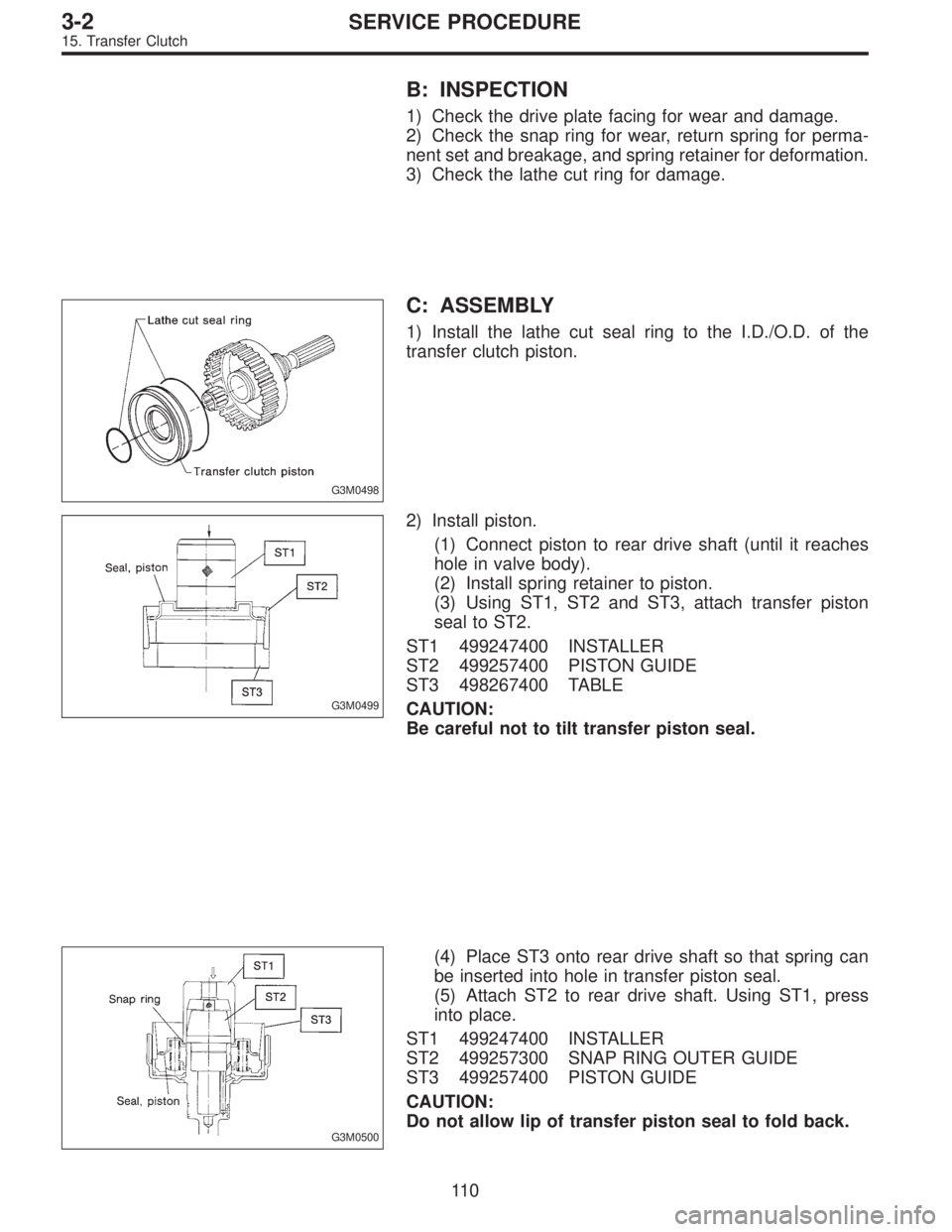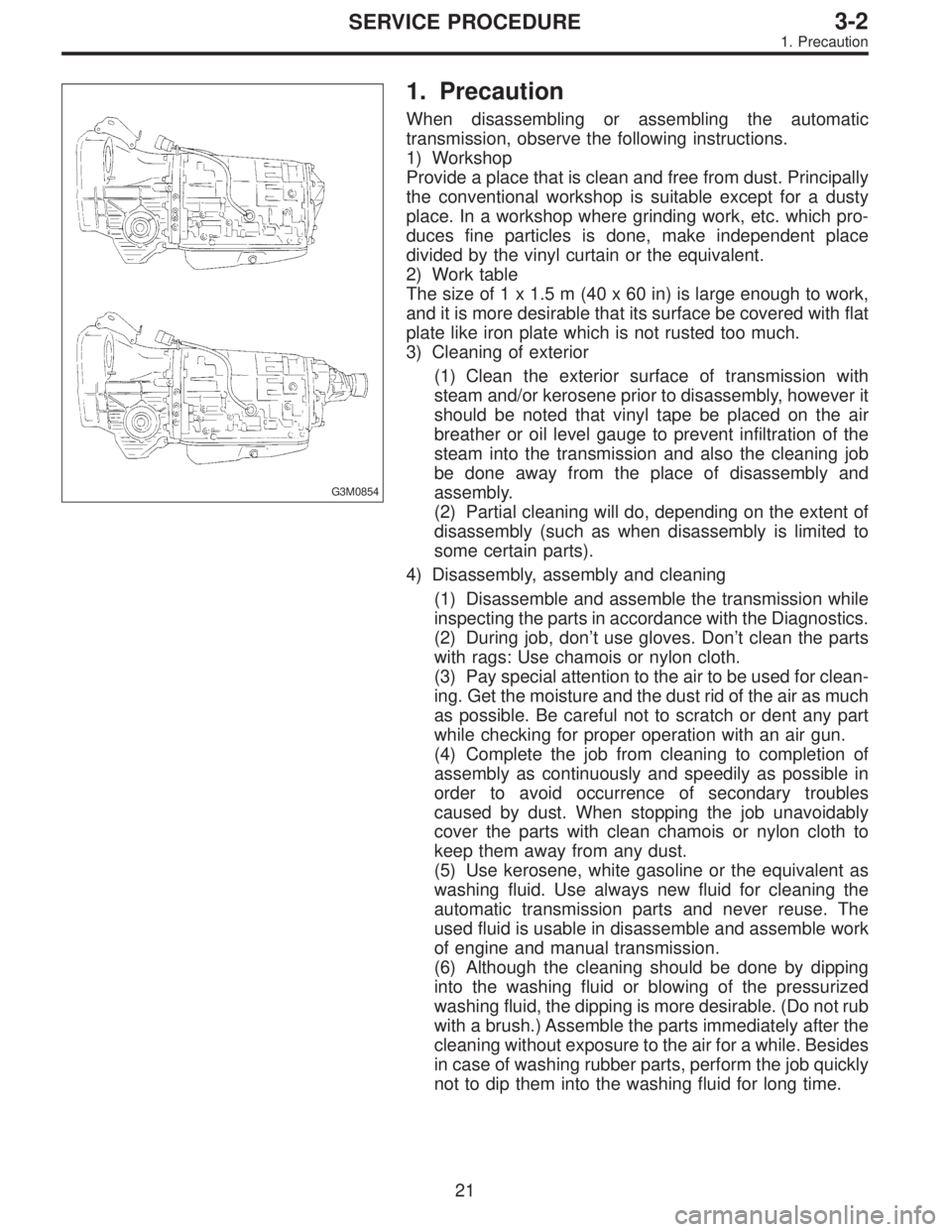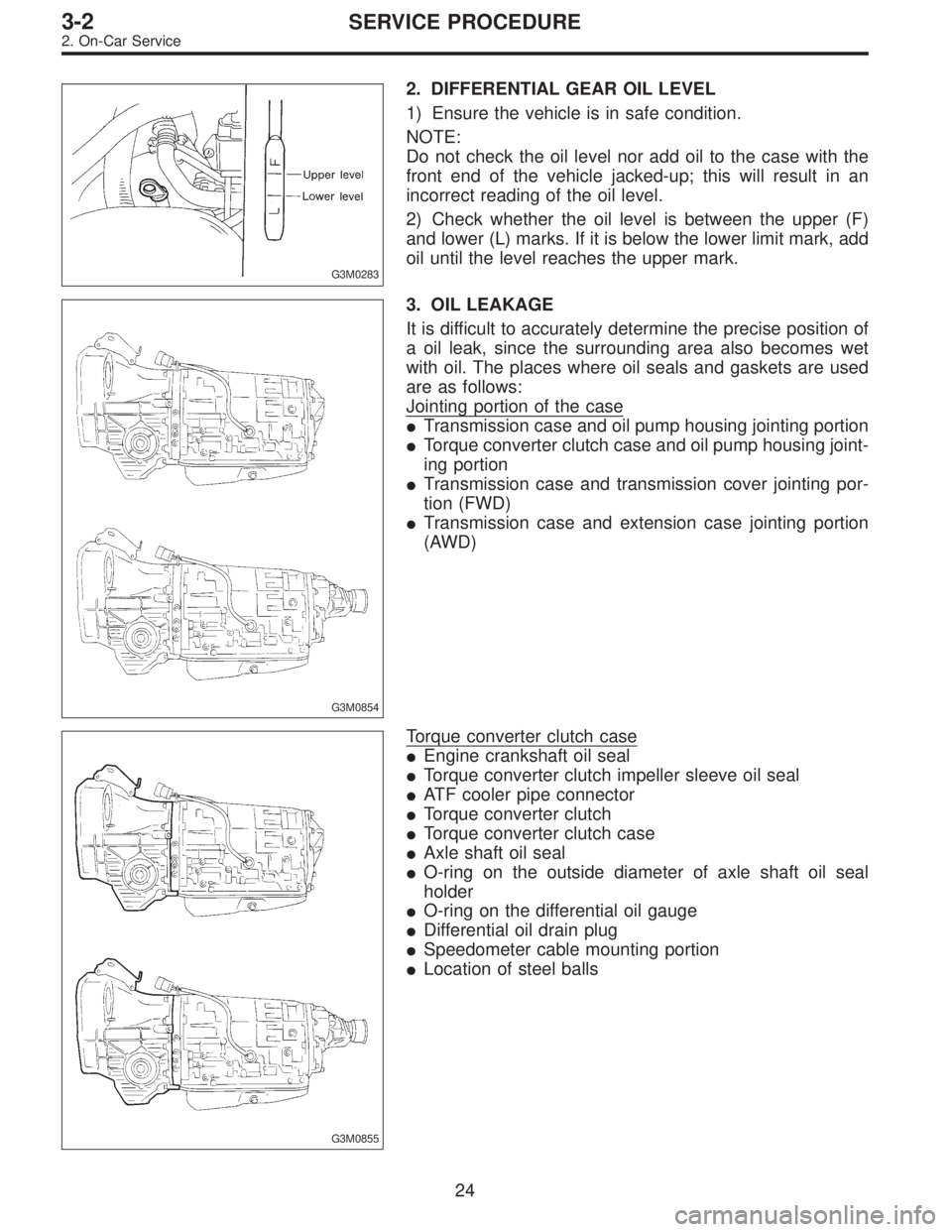Page 915 of 3342
G3M0493
15. Transfer Clutch
A: DISASSEMBLY
1) Remove the seal ring.
CAUTION:
Be careful not to damage the seal ring.
G3M0494
2) Using a press and ST, remove the ball bearing.
ST 498077000 REMOVER
CAUTION:
Do not reuse the bearing.
G3M0495
3) Remove the snap ring, and take out the pressure plate,
drive plates, and driven plates.
G3M0496
4) Remove the snap ring with ST1, ST2 and ST3, and take
out the spring retainer.
ST1 399893600 PLIERS
ST2 398673600 COMPRESSOR
ST3 498627000 SEAT
G3M0497
5) Apply compressed air to the rear drive shaft to remove
the piston.
109
3-2SERVICE PROCEDURE
15. Transfer Clutch
Page 916 of 3342

B: INSPECTION
1) Check the drive plate facing for wear and damage.
2) Check the snap ring for wear, return spring for perma-
nent set and breakage, and spring retainer for deformation.
3) Check the lathe cut ring for damage.
G3M0498
C: ASSEMBLY
1) Install the lathe cut seal ring to the I.D./O.D. of the
transfer clutch piston.
G3M0499
2) Install piston.
(1) Connect piston to rear drive shaft (until it reaches
hole in valve body).
(2) Install spring retainer to piston.
(3) Using ST1, ST2 and ST3, attach transfer piston
seal to ST2.
ST1 499247400 INSTALLER
ST2 499257400 PISTON GUIDE
ST3 498267400 TABLE
CAUTION:
Be careful not to tilt transfer piston seal.
G3M0500
(4) Place ST3 onto rear drive shaft so that spring can
be inserted into hole in transfer piston seal.
(5) Attach ST2 to rear drive shaft. Using ST1, press
into place.
ST1 499247400 INSTALLER
ST2 499257300 SNAP RING OUTER GUIDE
ST3 499257400 PISTON GUIDE
CAUTION:
Do not allow lip of transfer piston seal to fold back.
11 0
3-2SERVICE PROCEDURE
15. Transfer Clutch
Page 917 of 3342
G3M0501
3) Install the driven plates, drive plates, and pressure
plate, and secure with a snap ring with ST1, ST2 and a
press.
ST1 398673600 COMPRESSOR
ST2 498627000 SEAT
G3M0502
4) Apply compressed air to see if the assembled parts
move smoothly.
G3M0503
5) Check the clearance.
Standard value:
0.2—0.6 mm (0.008—0.024 in)
Allowable limit:
1.6 mm (0.063 in)
If the clearance is not within the specified range, select a
proper pressure plate.
NOTE:
Before measuring clearance, place the same thickness of
shim on both sides to prevent pressure plate from tilting.
�Available pressure platesPart No. Thickness mm (in)
31593AA151
31593AA161
31593AA171
31593AA1813.3 (0.130)
3.7 (0.146)
4.1 (0.161)
4.5 (0.177)
G3M0505
6) Press-fit the ball bearing with ST.
ST 899580100 INSTALLER
111
3-2SERVICE PROCEDURE
15. Transfer Clutch
Page 918 of 3342
G3M0505
7) Coat the seal ring with vaseline, and install it in the seal
ring groove of the shaft.
CAUTION:
Do not expand the seal ring excessively when install-
ing.
ST 899580100 INSTALLER
G3M0913
16. Transfer Valve Body
A: DISASSEMBLY
1) Remove the plate. Then remove the spring and pilot
valve together.
2) Remove the straight pin and pry out the plug with a
screwdriver. Then extract the spring and transfer clutch
valve together.
CAUTION:
Be careful not to damage the valve and valve body.
B: INSPECTION
Check each component for harmful cuts, damage, or other
faults.
C: ASSEMBLY
To assemble, reverse the removal sequence.
NOTE:
Make sure the valve slides smoothly after assembling.
11 2
3-2SERVICE PROCEDURE
15. Transfer Clutch - 16. Transfer Valve Body
Page 927 of 3342

G3M0854
1. Precaution
When disassembling or assembling the automatic
transmission, observe the following instructions.
1) Workshop
Provide a place that is clean and free from dust. Principally
the conventional workshop is suitable except for a dusty
place. In a workshop where grinding work, etc. which pro-
duces fine particles is done, make independent place
divided by the vinyl curtain or the equivalent.
2) Work table
The size of 1 x 1.5 m (40 x 60 in) is large enough to work,
and it is more desirable that its surface be covered with flat
plate like iron plate which is not rusted too much.
3) Cleaning of exterior
(1) Clean the exterior surface of transmission with
steam and/or kerosene prior to disassembly, however it
should be noted that vinyl tape be placed on the air
breather or oil level gauge to prevent infiltration of the
steam into the transmission and also the cleaning job
be done away from the place of disassembly and
assembly.
(2) Partial cleaning will do, depending on the extent of
disassembly (such as when disassembly is limited to
some certain parts).
4) Disassembly, assembly and cleaning
(1) Disassemble and assemble the transmission while
inspecting the parts in accordance with the Diagnostics.
(2) During job, don’t use gloves. Don’t clean the parts
with rags: Use chamois or nylon cloth.
(3) Pay special attention to the air to be used for clean-
ing. Get the moisture and the dust rid of the air as much
as possible. Be careful not to scratch or dent any part
while checking for proper operation with an air gun.
(4) Complete the job from cleaning to completion of
assembly as continuously and speedily as possible in
order to avoid occurrence of secondary troubles
caused by dust. When stopping the job unavoidably
cover the parts with clean chamois or nylon cloth to
keep them away from any dust.
(5) Use kerosene, white gasoline or the equivalent as
washing fluid. Use always new fluid for cleaning the
automatic transmission parts and never reuse. The
used fluid is usable in disassemble and assemble work
of engine and manual transmission.
(6) Although the cleaning should be done by dipping
into the washing fluid or blowing of the pressurized
washing fluid, the dipping is more desirable. (Do not rub
with a brush.) Assemble the parts immediately after the
cleaning without exposure to the air for a while. Besides
in case of washing rubber parts, perform the job quickly
not to dip them into the washing fluid for long time.
21
3-2SERVICE PROCEDURE
1. Precaution
Page 928 of 3342
G3M0854
(7) Apply the automatic transmission fluid (ATF) onto
the parts immediately prior to assembly, and the speci-
fied tightening torque should be observed carefully.
(8) Use vaseline if it is necessary to hold parts in the
position when assembling.
(9) Drain ATF and differential gear oil into a saucer so
that the conditions of fluid and oil can be inspected.
(10) Do not support axle drive shaft, stator shaft, input
shaft or various pipes when moving transmission from
one place to another.
(11) Always discard old oil seals and O-ring, and install
new ones.
(12) Do not reuse old aluminum (overrunning clutch
pipes, etc.) pipes, gaskets, spring pins. Install new
ones.
(13) Be sure to replace parts which are damaged,
worn, scratched, discolored, etc.
22
3-2SERVICE PROCEDURE
1. Precaution
Page 929 of 3342

G3M0282
2. On-Car Service
A: INSPECTION
1. ATF LEVEL
1) Raise ATF temperature to 60 to 80°C (140 to 176°F)
from 40 to 60°C (104 to 140°F) (when cold) by driving a
distance of 5 to 10 km (3 to 6 miles).
NOTE:
The level of ATF varies with fluid temperature. Pay atten-
tion to the fluid temperature when checking oil level.
2) Make sure the vehicle is level. After selecting all posi-
tions (P, R, N, D, 3, 2, 1), set the selector leveler in“P”
range. Measure fluid level with the engine idling.
NOTE:
After running, idle the engine for one or two minutes before
measurement.
3) If the fluid level is below the center between upper and
lower marks, add the recommended ATF until the fluid level
is found within the specified range (above the center
between upper and lower marks). When the transmission
is hot, the level should be above the center of upper and
lower marks, and when it is cold, the level should be found
below the center of these two marks.
CAUTION:
�Use care not to exceed the upper limit level.
�ATF level varies with temperature. Remember that
the addition of fluid to the upper limit mark when the
transmission is cold will result in the overfilling of
fluid.
4) Fluid temperature rising speed
�By idling the engine
Time for temperature rise to 60°C (140°F) with atmo-
spheric temperature of 0°C (32°F): More than 25 minutes
Time for temperature rise to 30°C (86°F) with atmo-
spheric temperature of 0°C (32°F): Approx. 8 minutes
�By running the vehicle
Time for temperature rise to 60°C (140°F) with atmo-
spheric temperature of 0°C (32°F): More than 10 minutes
5) Method for checking fluid level upon delivery or at peri-
odic inspection
Check fluid level after a warm-up run of approx. 10 min-
utes. During the warm-up period, the automatic transmis-
sion functions can also be checked.
23
3-2SERVICE PROCEDURE
2. On-Car Service
Page 930 of 3342

G3M0283
2. DIFFERENTIAL GEAR OIL LEVEL
1) Ensure the vehicle is in safe condition.
NOTE:
Do not check the oil level nor add oil to the case with the
front end of the vehicle jacked-up; this will result in an
incorrect reading of the oil level.
2) Check whether the oil level is between the upper (F)
and lower (L) marks. If it is below the lower limit mark, add
oil until the level reaches the upper mark.
G3M0854
3. OIL LEAKAGE
It is difficult to accurately determine the precise position of
a oil leak, since the surrounding area also becomes wet
with oil. The places where oil seals and gaskets are used
are as follows:
Jointing portion of the case
�Transmission case and oil pump housing jointing portion
�Torque converter clutch case and oil pump housing joint-
ing portion
�Transmission case and transmission cover jointing por-
tion (FWD)
�Transmission case and extension case jointing portion
(AWD)
G3M0855
Torque converter clutch case
�Engine crankshaft oil seal
�Torque converter clutch impeller sleeve oil seal
�ATF cooler pipe connector
�Torque converter clutch
�Torque converter clutch case
�Axle shaft oil seal
�O-ring on the outside diameter of axle shaft oil seal
holder
�O-ring on the differential oil gauge
�Differential oil drain plug
�Speedometer cable mounting portion
�Location of steel balls
24
3-2SERVICE PROCEDURE
2. On-Car Service